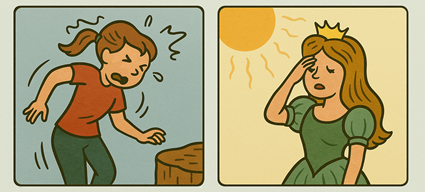Ever stood up too quickly and felt a sudden flash of dizziness?
Or stayed in the summer heat too long and felt your balance gently sway?
In Japanese, these sensations are expressed beautifully through sound:
Kura (くらっ)
Kurari (くらり)
What is “Kura” (くらっ)?
A short, sharp dizziness.
Used for: sudden lightheadedness, standing up quickly, or a brief dizzy spell.
Nuance: instant, abrupt, momentary.
Example:
She stood up suddenly,
and her vision blurred —
kura…!
Pronunciation
koo-rah (short, clipped, quick)

What is “Kurari” (くらり)?
A soft, swaying dizziness.
Used for: heatstroke, fatigue, or emotional faintness.
Nuance: gentle, floating, drawn out — a subtle swaying rather than a sudden flash.
Example:
After walking in the hot sun,
her head swayed lightly —
kurari…
Pronunciation
koo-rah-ree (slightly longer, swaying)

Cultural Note
In English, you might simply say:
“Feeling faint.”
“Dizzy.”
“My head spun.”
But in Japanese, the distinction is clear:
Kura (くらっ) = short and sudden
Kurari (くらり) = gentle and swaying
That’s why in literature or manga, Kura (くらっ) is often used for a quick shock or sudden dizziness, while Kurari (くらり) paints a softer, almost floating faintness.
Examples in Daily Life

Example 1: Sudden dizziness (Kura)
She jumped up too quickly —
kura!
Example 2: Heat-induced faintness (Kurari)
The hot sun blurred her vision —
kurari…
Try Using Them!
When you feel a sharp flash of dizziness,
say kura!
When you feel yourself sway gently with fatigue,
say kurari…












Comments